Zihan Zhao
A Clinical-grade Universal Foundation Model for Intraoperative Pathology
Oct 06, 2025Abstract:Intraoperative pathology is pivotal to precision surgery, yet its clinical impact is constrained by diagnostic complexity and the limited availability of high-quality frozen-section data. While computational pathology has made significant strides, the lack of large-scale, prospective validation has impeded its routine adoption in surgical workflows. Here, we introduce CRISP, a clinical-grade foundation model developed on over 100,000 frozen sections from eight medical centers, specifically designed to provide Clinical-grade Robust Intraoperative Support for Pathology (CRISP). CRISP was comprehensively evaluated on more than 15,000 intraoperative slides across nearly 100 retrospective diagnostic tasks, including benign-malignant discrimination, key intraoperative decision-making, and pan-cancer detection, etc. The model demonstrated robust generalization across diverse institutions, tumor types, and anatomical sites-including previously unseen sites and rare cancers. In a prospective cohort of over 2,000 patients, CRISP sustained high diagnostic accuracy under real-world conditions, directly informing surgical decisions in 92.6% of cases. Human-AI collaboration further reduced diagnostic workload by 35%, avoided 105 ancillary tests and enhanced detection of micrometastases with 87.5% accuracy. Together, these findings position CRISP as a clinical-grade paradigm for AI-driven intraoperative pathology, bridging computational advances with surgical precision and accelerating the translation of artificial intelligence into routine clinical practice.
An Explainable Emotion Alignment Framework for LLM-Empowered Agent in Metaverse Service Ecosystem
Jul 30, 2025



Abstract:Metaverse service is a product of the convergence between Metaverse and service systems, designed to address service-related challenges concerning digital avatars, digital twins, and digital natives within Metaverse. With the rise of large language models (LLMs), agents now play a pivotal role in Metaverse service ecosystem, serving dual functions: as digital avatars representing users in the virtual realm and as service assistants (or NPCs) providing personalized support. However, during the modeling of Metaverse service ecosystems, existing LLM-based agents face significant challenges in bridging virtual-world services with real-world services, particularly regarding issues such as character data fusion, character knowledge association, and ethical safety concerns. This paper proposes an explainable emotion alignment framework for LLM-based agents in Metaverse Service Ecosystem. It aims to integrate factual factors into the decision-making loop of LLM-based agents, systematically demonstrating how to achieve more relational fact alignment for these agents. Finally, a simulation experiment in the Offline-to-Offline food delivery scenario is conducted to evaluate the effectiveness of this framework, obtaining more realistic social emergence.
ChemDFM-R: An Chemical Reasoner LLM Enhanced with Atomized Chemical Knowledge
Jul 30, 2025Abstract:While large language models (LLMs) have achieved impressive progress, their application in scientific domains such as chemistry remains hindered by shallow domain understanding and limited reasoning capabilities. In this work, we focus on the specific field of chemistry and develop a Chemical Reasoner LLM, ChemDFM-R. We first construct a comprehensive dataset of atomized knowledge points to enhance the model's understanding of the fundamental principles and logical structure of chemistry. Then, we propose a mix-sourced distillation strategy that integrates expert-curated knowledge with general-domain reasoning skills, followed by domain-specific reinforcement learning to enhance chemical reasoning. Experiments on diverse chemical benchmarks demonstrate that ChemDFM-R achieves cutting-edge performance while providing interpretable, rationale-driven outputs. Further case studies illustrate how explicit reasoning chains significantly improve the reliability, transparency, and practical utility of the model in real-world human-AI collaboration scenarios.
Reasoning-Driven Retrosynthesis Prediction with Large Language Models via Reinforcement Learning
Jul 23, 2025Abstract:Retrosynthesis planning, essential in organic synthesis and drug discovery, has greatly benefited from recent AI-driven advancements. Nevertheless, existing methods frequently face limitations in both applicability and explainability. Traditional graph-based and sequence-to-sequence models often lack generalized chemical knowledge, leading to predictions that are neither consistently accurate nor easily explainable. To address these challenges, we introduce RetroDFM-R, a reasoning-based large language model (LLM) designed specifically for chemical retrosynthesis. Leveraging large-scale reinforcement learning guided by chemically verifiable rewards, RetroDFM-R significantly enhances prediction accuracy and explainability. Comprehensive evaluations demonstrate that RetroDFM-R significantly outperforms state-of-the-art methods, achieving a top-1 accuracy of 65.0% on the USPTO-50K benchmark. Double-blind human assessments further validate the chemical plausibility and practical utility of RetroDFM-R's predictions. RetroDFM-R also accurately predicts multistep retrosynthetic routes reported in the literature for both real-world drug molecules and perovskite materials. Crucially, the model's explicit reasoning process provides human-interpretable insights, thereby enhancing trust and practical value in real-world retrosynthesis applications.
Breaking Thought Patterns: A Multi-Dimensional Reasoning Framework for LLMs
Jun 16, 2025Abstract:Large language models (LLMs) are often constrained by rigid reasoning processes, limiting their ability to generate creative and diverse responses. To address this, a novel framework called LADDER is proposed, combining Chain-of-Thought (CoT) reasoning, Mixture of Experts (MoE) models, and multi-dimensional up/down-sampling strategies which breaks the limitations of traditional LLMs. First, CoT reasoning guides the model through multi-step logical reasoning, expanding the semantic space and breaking the rigidity of thought. Next, MoE distributes the reasoning tasks across multiple expert modules, each focusing on specific sub-tasks. Finally, dimensionality reduction maps the reasoning outputs back to a lower-dimensional semantic space, yielding more precise and creative responses. Extensive experiments across multiple tasks demonstrate that LADDER significantly improves task completion, creativity, and fluency, generating innovative and coherent responses that outperform traditional models. Ablation studies reveal the critical roles of CoT and MoE in enhancing reasoning abilities and creative output. This work contributes to the development of more flexible and creative LLMs, capable of addressing complex and novel tasks.
ProgRM: Build Better GUI Agents with Progress Rewards
May 23, 2025Abstract:LLM-based (Large Language Model) GUI (Graphical User Interface) agents can potentially reshape our daily lives significantly. However, current LLM-based GUI agents suffer from the scarcity of high-quality training data owing to the difficulties of trajectory collection and reward annotation. Existing works have been exploring LLMs to collect trajectories for imitation learning or to offer reward signals for online RL training. However, the Outcome Reward Model (ORM) used in existing works cannot provide finegrained feedback and can over-penalize the valuable steps in finally failed trajectories. To this end, we propose Progress Reward Model (ProgRM) to provide dense informative intermediate rewards by predicting a task completion progress for each step in online training. To handle the challenge of progress reward label annotation, we further design an efficient LCS-based (Longest Common Subsequence) self-annotation algorithm to discover the key steps in trajectories and assign progress labels accordingly. ProgRM is evaluated with extensive experiments and analyses. Actors trained with ProgRM outperform leading proprietary LLMs and ORM-trained actors, illustrating the effectiveness of ProgRM. The codes for experiments will be made publicly available upon acceptance.
A Survey of Large Language Models for Text-Guided Molecular Discovery: from Molecule Generation to Optimization
May 22, 2025Abstract:Large language models (LLMs) are introducing a paradigm shift in molecular discovery by enabling text-guided interaction with chemical spaces through natural language, symbolic notations, with emerging extensions to incorporate multi-modal inputs. To advance the new field of LLM for molecular discovery, this survey provides an up-to-date and forward-looking review of the emerging use of LLMs for two central tasks: molecule generation and molecule optimization. Based on our proposed taxonomy for both problems, we analyze representative techniques in each category, highlighting how LLM capabilities are leveraged across different learning settings. In addition, we include the commonly used datasets and evaluation protocols. We conclude by discussing key challenges and future directions, positioning this survey as a resource for researchers working at the intersection of LLMs and molecular science. A continuously updated reading list is available at https://github.com/REAL-Lab-NU/Awesome-LLM-Centric-Molecular-Discovery.
Towards Efficient Large Multimodal Model Serving
Feb 02, 2025Abstract:Recent advances in generative AI have led to large multi-modal models (LMMs) capable of simultaneously processing inputs of various modalities such as text, images, video, and audio. While these models demonstrate impressive capabilities, efficiently serving them in production environments poses significant challenges due to their complex architectures and heterogeneous resource requirements. We present the first comprehensive systems analysis of two prominent LMM architectures, decoder-only and cross-attention, on six representative open-source models. We investigate their multi-stage inference pipelines and resource utilization patterns that lead to unique systems design implications. We also present an in-depth analysis of production LMM inference traces, uncovering unique workload characteristics, including variable, heavy-tailed request distributions, diverse modal combinations, and bursty traffic patterns. Our key findings reveal that different LMM inference stages exhibit highly heterogeneous performance characteristics and resource demands, while concurrent requests across modalities lead to significant performance interference. To address these challenges, we propose a decoupled serving architecture that enables independent resource allocation and adaptive scaling for each stage. We further propose optimizations such as stage colocation to maximize throughput and resource utilization while meeting the latency objectives.
Learning Symmetry-Independent Jet Representations via Jet-Based Joint Embedding Predictive Architecture
Dec 05, 2024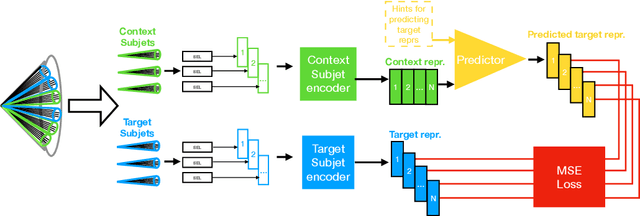
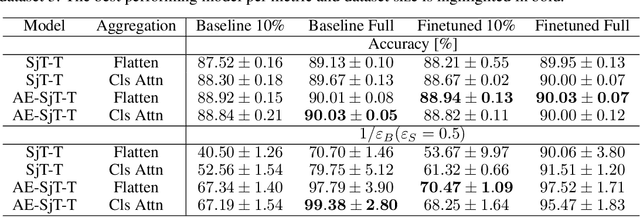
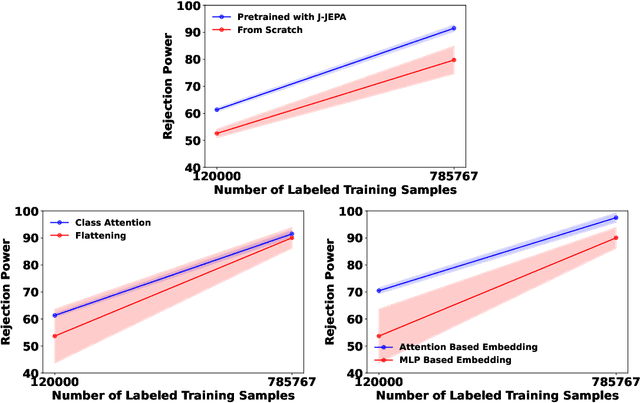
Abstract:In high energy physics, self-supervised learning (SSL) methods have the potential to aid in the creation of machine learning models without the need for labeled datasets for a variety of tasks, including those related to jets -- narrow sprays of particles produced by quarks and gluons in high energy particle collisions. This study introduces an approach to learning jet representations without hand-crafted augmentations using a jet-based joint embedding predictive architecture (J-JEPA), which aims to predict various physical targets from an informative context. As our method does not require hand-crafted augmentation like other common SSL techniques, J-JEPA avoids introducing biases that could harm downstream tasks. Since different tasks generally require invariance under different augmentations, this training without hand-crafted augmentation enables versatile applications, offering a pathway toward a cross-task foundation model. We finetune the representations learned by J-JEPA for jet tagging and benchmark them against task-specific representations.
AuscultaBase: A Foundational Step Towards AI-Powered Body Sound Diagnostics
Nov 12, 2024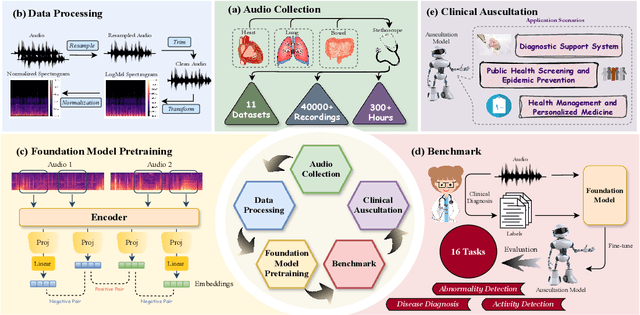
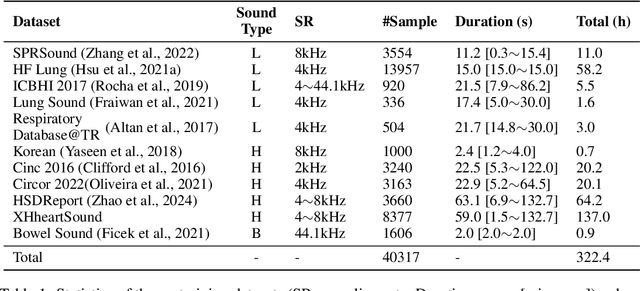
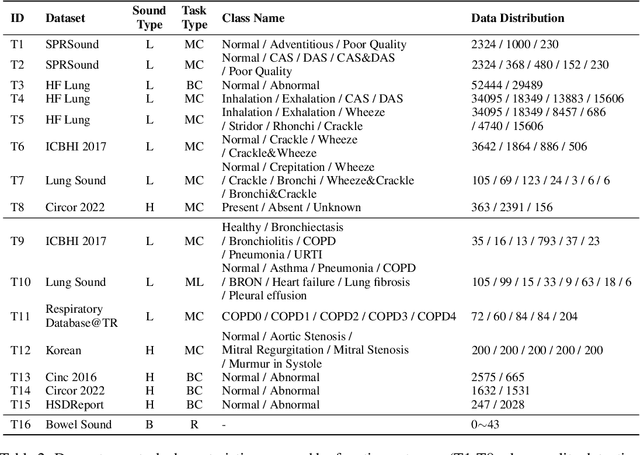
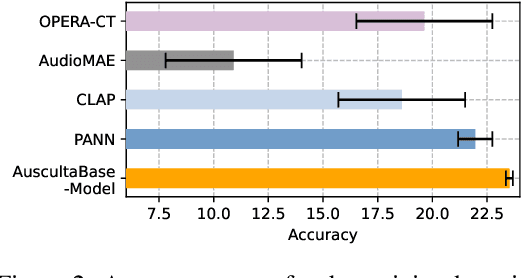
Abstract:Auscultation of internal body sounds is essential for diagnosing a range of health conditions, yet its effectiveness is often limited by clinicians' expertise and the acoustic constraints of human hearing, restricting its use across various clinical scenarios. To address these challenges, we introduce AuscultaBase, a foundational framework aimed at advancing body sound diagnostics through innovative data integration and contrastive learning techniques. Our contributions include the following: First, we compile AuscultaBase-Corpus, a large-scale, multi-source body sound database encompassing 11 datasets with 40,317 audio recordings and totaling 322.4 hours of heart, lung, and bowel sounds. Second, we develop AuscultaBase-Model, a foundational diagnostic model for body sounds, utilizing contrastive learning on the compiled corpus. Third, we establish AuscultaBase-Bench, a comprehensive benchmark containing 16 sub-tasks, assessing the performance of various open-source acoustic pre-trained models. Evaluation results indicate that our model outperforms all other open-source models in 12 out of 16 tasks, demonstrating the efficacy of our approach in advancing diagnostic capabilities for body sound analysis.
 Add to Chrome
Add to Chrome Add to Firefox
Add to Firefox Add to Edge
Add to Edge